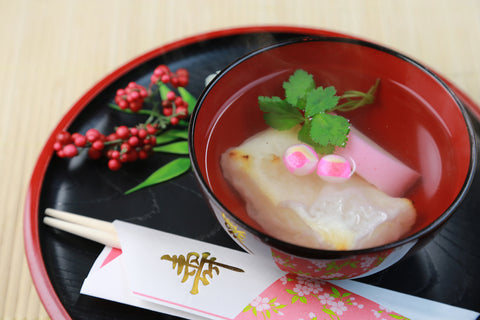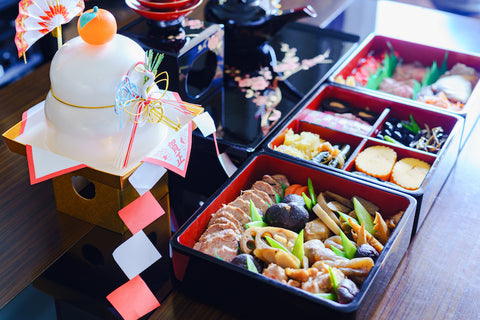Rarely does a Japanese celebration not include Sake.
Japanese New Year is a three day celebration
Collectively called Sanganichi 三が日, starting with the 1st of January, Gantan 元旦.
New Year’s is the one solid time of the year the hard working nation took a complete break. All shops and services closed and the streets went quiet, New Year’s food, Osechi, was prepared by 31st December to last for the three days so the cooks in the family could also take a rest – although things are changing now, and the three day period is turning into a sale season.

Kampai with Otoso or Toso お屠蘇
New Year’s morning starts with a toast with herbal sake, Otoso, praying for a long and healthy year ahead. The words have the meaning of fending away bad or evil energy and revitalising the mind and body. It was believed that drinking this with the whole family would keep the family and the town safe for the entire year.

Rules of the Game
Manners and practise can vary from regions to household, here is one general example.
- Toso is exchanged at the beginning of the meal, before Osechi and Ozoni (mochi soup)
- Everyone present faces the east
- The youngest person is served first. They take the sake cup called sakazuki 盃, and the eldest person pours. The same sakazuki is passed onto the second youngest person and the youngest person pours them some sake, and so on until everyone has been served. It is a rare occasion that younger people are served first in Japan. There are two reasons for this formality, one is the old tradition of dokumi 毒味, making sure the Toso is not poisoned, and secondly to pass some of the youthfulness to the elders.
- Chant ‘一人これを飲めば一家くるしみなく、一家これを飲めば一里病なし’ before sipping. Pronounced ‘Hitori korewo nomeba ikka kurushimi naku, ikka korewo nomeba hitosato yamai nashi‘ meaning, ‘one drinks this and the whole family is happy, the whole family drinks this and the whole town will be healthy‘
Formally, each person will sip once once out of all three sakazuki starting with the smallest one, but a simplified version is more common; three small pours into one cup and sipped three times.
What is Toso made of?
The traditional celebratory drink is made by infusing herbs, called Tososan 屠蘇散 in sake for a whole night.
There are various different blends of herbs on record, but they generally include;
・Eastern ukera root オケラの根(白朮)
・Japanese pepper サンショウの実(蜀椒)
・Siler root ボウフウの根(防風)
・Balloon flower root キキョウの根(桔梗)
・Cinnamon ニッケイの樹皮(桂皮)
・Orange peel ミカンの皮(陳皮)
These herbs warm the body, encourage gut health, and prevent colds. Older recipes are said to have included stronger herbs are but less so in modern times. Of course, drivers and small children can pretend to sip.

So Restaurant Osechi Set includes Tososan
The good news is, the So Restaurant Osechi Selection includes a Tososan sachet. All you need to prepare, is a bottle of mirin or sake. Mirin is similar to sake, but has more sugar and less alcohol content. It is a staple condiment in Japanese kitchens and is often used with soy sauce in casseroles and sauces like teriyaki.
Otoso made with mirin will be a little sweeter and less alcoholic than if you made it with Sake. If you do opt to make with mirin, try to purchase ‘Hon mirin’ that is the pure kind with no additional sweeteners or salt.
The quality of the sake or mirin will greatly affect the taste of your Otoso.
Order your Osechi set with Tososan today!
How to make Otoso
1. Prepare 300 ml of Sake or Mirin (or a mix of both) and sink in the tososan sachet.
2. Leave for 5-8 hours and take out the sachet. If infused for too long, the otoso may end up cloudy with sediments.
History
The custom of Otoso drinking is said to have arrived from China, in the Heian era 平安時代 (794-1185). It started off as a New Year’s ceremony in the palace but gradually spread during the Edo period when economic growth allowed for villagers to also enjoy such delicacies.


